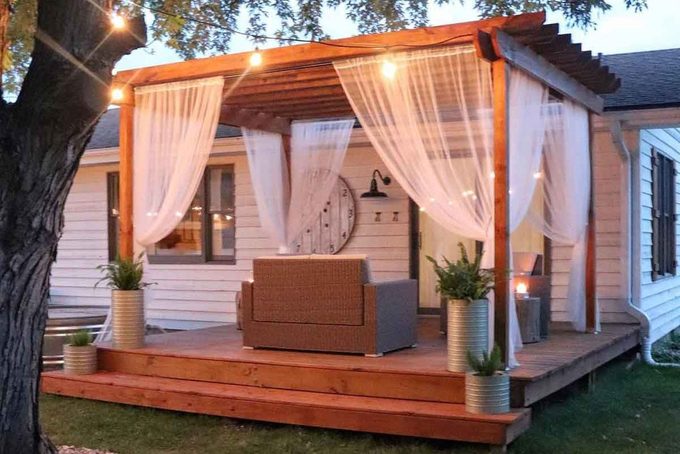Pergola versus gazebo—both add charm to your space, just in different ways

Pergola vs Gazebo: Which Outdoor Structure Is Right for You?

Weighing the pergola versus gazebo dilemma can be tricky, as they differ in size, structure and functionality. From cost comparison and durability to maintenance, here’s everything you need to know before you make a final call on the pergolas versus gazeboes debate to create a beautiful and practical structure in your garden.
On This Page
What’s the Difference Between a Pergola and Gazebo?
The main difference lies in the roof design. A pergola offers an open-roof design with columns supporting crossbeams, creating a partially shaded area that allows sunlight to filter through.
A gazebo provides complete coverage with a fully enclosed roof, usually elevated off the ground on a concrete slab or wooden deck. It will often have a rounded or octagonal shape.
Advantages of Pergolas
Light control
You can customize the open-beam design of pergolas. This can result in visually striking outcomes. Options include:
- Retractable canopies that you can adjust
- Growing vines along the vertical columns and across the top to create a shaded canopy
- Hanging fabric panels between beams for more coverage
Moreover, a pergola can block around 70% of direct sunlight when paired with a latticework design.
Easier maintenance
Pergolas require less maintenance than gazebos, especially when built with weather-resistant materials like vinyl or aluminium.
- The open design allows rain to pass through rather than collect, drastically cutting down on the risk of water damage and the resulting mould growth.
- Annual maintenance is simple and involves basic cleaning and applying weather-resistant sealant to the wood.
Advantages of Gazebos
Full weather protection
Unless you are extremely fortunate to be living in an area with mild weather conditions throughout the year, gazebos are your best bet. They have solid roofs that offer protection from rain and intense sun, making them ideal for regions with frequent rain or extremely hot climates.
However, for regions with moderate to heavy snowfall during winter, you will need to modify your gazebo with gable roofs for better durability against snow accumulation.
Creating defined outdoor rooms
The enclosed nature of gazebos creates distinct “rooms” within your landscape. Your garden refuge is now fit for hosting outdoor dinners. They can also double up as hot tub enclosures or meditation spaces.
Considerations for Building a Pergola Vs. Gazebo
Cost
Pergolas are lighter on your wallet. For example, a standard 9-foot wooden model usually costs between $2,000 and $6,000. In comparison, a gazebo of the same size could cost you about $5,000 to $10,000 due to the additional materials needed for full roofing, elevated flooring, and more complex construction.
For pergolas, your choice of material will significantly impact cost, with vinyl and aluminium options being the most expensive. One upside is that building a pergola is relatively simple, especially with DIY kits that are available for as little as $1,500.
Materials and Installation
Pergolas
With a variety of options for materials, you could simplify the decision-making process by prioritizing upfront cost, aesthetics and durability in the preferred order.
- Wood: If you are looking for a natural aesthetic that weathers well
- Vinyl: In case you want to choose the low-maintenance option, as vinyl resists weathering and doesn’t require painting
- Fibreglass: If you want to move the pergola to a different location, fibreglass is durable and won’t warp or rot
- Aluminium: Probably not as stylish as the other options, but aluminium makes up for it in the sheer functionality of being rust-resistant, making it ideal for coastal environments
For installations, pergola kits offer pre-designed plans to simplify the process. DIY enthusiasts can build custom pergolas using widely available plans, although this will require more advanced carpentry skills.
Gazebos
Gazebos are typically made from these materials:
- Wood: Traditional gazebos are made from cedar, pine, and redwood
- Stone: Using stone for bases and columns is a fairly standard building practice for gazebos
- Metal: Wrought iron or aluminium provides durability in various weather conditions, but aluminium scores over iron, being lightweights and easier to maintain
And, of course, you have the option of prefabricated gazebo kits that are ready-made and easier to assemble. However, custom-built DIY gazebos offer unique designs, more suitable to specific needs.
Durability
Pergolas’ lower cost and easier maintenance come at the cost of durability when compared with gazebos. They lack an enclosed roof, so there’s limited protection for the columns and beams. Wood pergolas are more prone to premature deterioration. They also have weaker construction since they don’t have as strong of a foundation. But that doesn’t mean you can’t enjoy a pergola for a long time. A well-built and properly maintained pergola can last 10-12 years or more with proper maintenance.
Gazebos typically have sturdier structures than pergolas. However, durability depends on materials, weather conditions and maintenance efforts. Your gazebo is likely to last longer when built with galvanized steel or aluminium instead of lower-quality metals. While building with the right materials is important, you can’t stress enough the importance of regular maintenance to prevent rust and corrosion. For roofing, asphalt shingle roofs would save you on upfront cost but are not as durable as other more expensive options.
Pergola vs gazebo: Which option is best for you?
Finally, if your pergola versus gazebo dilemma remains intact, consider these parameters to help clear the fog:
- Available space: What’s the available area in your yard? Gazebos require more area, while pergolas can adapt to smaller areas
- Neighborhood context: Have you noticed what your neighbours have installed? Look around and see which structures are more common in your area. This is often a good indicator of which option is more popular where you live
- Primary usage: Do you enjoy hosting dinner parties? If the answer is yes, then the weather protection that gazebos provide will suit you. On the flip side, lounging spaces are better suited to the airiness of pergolas
- Maintenance: Are you already overwhelmed with maintaining your property but still want an addition to your garden? Pergolas are a more suitable option
- Budget constraints: Factor in both initial and ongoing maintenance costs
- Building permits: Checking building codes for your area should ideally be on the top of your checklist before considering other pergola vs gazebo questions
FAQs
Which direction should a pergola face?
You get the best shade coverage with north-south aligned beams that have a slight eastward angle. This allows abundant morning and afternoon shade, while east-west beams provide minimal coverage from the sun.
Does a gazebo need to be on concrete?
Yes, a level concrete slab makes a gazebo durable. The idea is to have a thick concrete base to support the structure and furnishings.
Can a pergola be moved easily?
Yes, a pergola can be moved, but ease of movement depends on its design, materials, and foundation. Modular, lightweight options like fibreglass are easier to relocate.
Primary Sources:
FIXR: “Pergola vs Gazebo”
HARBOUR: “Gazebo vs. Pergola: Differences, Ideas & Costs”
Gardens of Style: “PERGOLA VS. GAZEBO: WHICH IS CHEAPER?”
Hanso: “PERGOLA VS GAZEBO: WHAT’S THE DIFFERENCE? WHICH IS BETTER?”



















